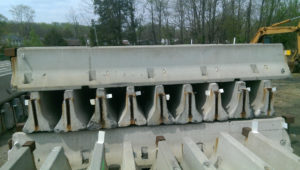Concrete barriers serve as essential elements in traffic management, construction, and security. Weighing 400-500 pounds per linear foot, moving them requires careful planning, proper equipment, and adherence to safety protocols to prevent accidents and injuries. Our team at 48Barriers has extensive experience working with jersey barriers, so here are some of our explore the best practices for moving them.

Planning and Preparation:
Before initiating any concrete barrier handling operation, layout your transportation plan first.
- Assess the site conditions and layout to determine the best routes for transportation and placement of barriers.
- Ensure adequate manpower and resources are available for the task.
- Check to see if you need any approvals for barrier placement or road closures, if applicable.
- Communicate with the team to establish clear roles, responsibilities, and safety procedures.
Types of Lifting Equipment:
Moving K-rail barriers safely and efficiently requires specialized equipment designed for heavy lifting and transportation:
- Forklifts: If your barriers are equipped with forklift slots, this is the easiest way to move them around. Originally, these slots were designed for optimal drainage, so make sure your barrier lift clamps down on the top of the barrier to avoid damage.
- Kenco adapters: This forklift adapter is ideal if you need to move irregular objects in addition to barriers. This can be added onto a regular forklift to move objects up to 12,000 pounds.
- Bin block lifters: Lifters like this one from Kenco can move bin blocks up to 6,000 pounds. Using this type of lifter helps eliminate unnecessary extra labor by setting blocks into place without the need to hook into the lifting ring.
Safe Lifting and Transport Procedures:
Here are some additional best practices to ensure safe lifting and transportation of concrete barriers:
- Inspect barriers for any signs of damage, cracks, or structural weaknesses before lifting.
- Position the lifting equipment or barrier lifters securely on the barrier edges, ensuring proper alignment and engagement.
- Lift the barrier gradually and smoothly, avoiding sudden movements or jerks that could destabilize the load.
- Observe proper load capacity limits and weight distribution on forklifts or trucks to prevent overloading or instability.
- Secure barriers with straps, chains, or other restraints to prevent shifting or falling during transit.
- Use caution when navigating uneven terrain, slopes, or obstacles to prevent tipping or loss of control.
By following best practices for lifting and transport procedures and prioritizing personal safety precautions, teams can effectively manage concrete barrier installations while minimizing risks to personnel and property. Remember, safety is paramount in all construction and traffic management activities.
Stay safe and ensure concrete barrier handling operation is executed with precision and care. Contact us for more information about tools and practices for barrier lifting!





